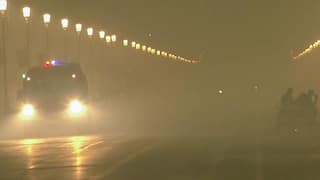Antarctica's Only Active Volcano Has Lava Lakes On The Surface. New Study Reveals Why
The study has explained how carbon dioxide deep underground helps magma avoid being trapped deep in the Earth, and allows it to reach and pool the surface, resulting in the formation of lava lakes.

New Delhi: The Antarctic continent has long been a land of mystery and heroic achievements made famous by the explorations of James Ross, Roald Amundsen, Robert Scott, and Ernest Shackleton. Antarctica contains examples which define the spectrum of Earth's volcanic processes, and which represent a key piece of the puzzle for understanding global continental evolution.
A new study, conducted by researchers at University of Utah and University of Canterbury New Zealand has explained how carbon dioxide deep underground helps magma avoid being trapped deep in the Earth, and allows it to reach and pool the surface, resulting in the formation of lava lakes.
The study was recently published in the journal Nature Communications. Phil Wannamaker, the second author on the paper, said the study expands on researchers' understanding of the sources and transport of diverse types of magma and volatile gases to the surface.
Mount Erebus Is Carbon Dioxide-Dominated Rift Volcano
Graham Hill, the lead author on the paper, said that Mount Erebus is an example of a carbon dioxide-dominated rift volcano, a complement to the more widely known arc volcanoes of the Pacific Rim and elsewhere, dominated by water.
Arc volcanoes are a chain of volcanoes, hundreds to thousands of miles long, that form above a subduction zone, which is the area of collision between two of Earth's tectonic plates, where one plate sinks into the mantle underneath the other plate. Rift volcanoes form when magma rises into the gap between diverging plates.
Wannamaker added that understanding both water and carbon dioxide volcanoes is important for calculating the budget of such volatile gases deep in the Earth that involves injection of material into Earth's mantle and its return to the surface to start all over again.
All About Mount Erebus
Mount Erebus, Antarctica's only active volcano, and its dormant companion volcano, Mount Terror, were named after the exploring ships of Sir James Ross, who discovered them and the Transantarctic Mountains in 1841. In 1908, Sir Ernest Shackleton and his teammates became the first persons to ascend Mount Erebus.
Mount Erebus belongs to a family of volcanoes with an alkalic chemical composition, with lavas relatively rich in sodium, potassium and other elements including Earth's rare elements. The mountain is relatively poor in silica.
Characteristics Of Volcanoes In Cascade Range
Alkalic volcanoes, which are rich in sodium and potassium, are very different from volcanoes such as those in the Cascade Range which extends from northern California through British Columbia to Alaska. The volcanoes in the Cascade Range are found in a place where Earth's tectonic plates are pushing toward each other. Also, the crust of the ocean is forced below the crust of the continent. The water in the rocks becomes part of the melt, as that ocean crust sinks into the Earth and partially melts.
The water is the dominant "volatile", or the molecule that easily changes into gaseous form.
According to the study, the evolving magma in the Cascades rises into and through the crust, but does not make it to the surfaces because the water flashes out as the pressure from the overlying crust diminishes with ascent. Sometimes, the water flashes out explosively as in the case of Mount St Helens in 1980 or Mount Lassen in 1912. Meanwhile, the remaining magma stalls and freezes in place. This usually occurs at a depth of around three miles or five kilometres.
Mount Erebus Is In A Continental Rift Zone. Know What It Means
However, Erebus volcano on Ross Island, Antarctica, is in a continental rift zone, which is created as a result of Earth's crust and mantle being pulled apart. Western Utah, an example of a rift zone, lies in the eastern boundary of the actively rifting Great Basin geological province, and is being slowly stretched east-west. Mount Erebus lies along the margin of the West Antarctic Rift System, which originated tens of millions of years ago.
Volatiles produced as a result of recycling of oceanic crust and sediments are present in the magmas of Erebus.
However, these are much older and are liberated to the surface through the rift process. The volatiles in these magmas are carbon dioxide-dominated, instead of being water-dominated.
Erebus also has a persistent lava lake, which is a classic feature of an evolved, carbon dioxide-rich rift volcano. Lava lakes such as the Nyiragongo volcano in East Africa are not found in arc volcanoes like the Cascades, and show that there must be something about rift volcanoes which allows magma to reach the surface relatively peacefully.
How Researchers Picture Magma Within The Earth
Since collecting samples of rocks from depths of more than a few kilometres beneath the surface of Earth is impractical, researchers rely on geophysical methods to understand structures and processes at greater depths, similar to computed tomography (CT) scanning of the human body.
Seismic techniques are the most widely applied and familiar geophysical techniques. Sound waves are used for internal imaging of different structures and substances, including oil and gas.
According to the study, natural seismic sources that can reach deep into the Earth are sparse around Erebus volcano. Hence, images using such natural sources have only been derived to shallow depths.
What Is Magnetotelluric Sounding?
The researchers used a method called magnetotelluric sounding, which uses natural electromagnetic waves generated by the Sun and by lighting bolts.
Though most such waves travel through the air, a portion can penetrate the Earth, scatter off rock surfaces of interest, and return to the surface, where they can be measured using sophisticated voltmeters, according to Wannamaker.
The electromagnetic waves which pass through Earth's interior travel faster or slower depending on the extent to which rock and other material conducts or resists electricity. Since magma is conductive, it can be detected by this technique.
How Does Magma Rise To The Volcano’s Lava Lake?
The carbon dioxide-dominated Erebus has structures which allow the magma to rise right to the volcano's lake, unlike the water-rich arc volcanoes of the Cascades and the Pacific Rim. The magma is able to rise right to the volcano's lava lake because it does not stall in the crust like water-dominated magmas, the study concludes.
Wannamaker said that such volcanoes elsewhere are important hosts for essential mineral deposits such as rare Earth elements, which are increasingly important for societies' future resource needs.






































